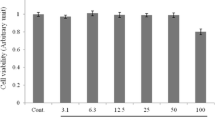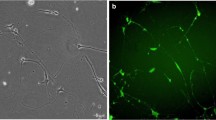Abstract
Erythropoietin (EPO) may become a potential therapeutic candidate for the treatment of the neurodegenerative disorder — Parkinson’s disease (PD), since EPO has been found to prevent neuron apoptosis through the activation of cell survival signalling. However, the underlying mechanisms of how EPO exerts its neuroprotective effect are not fully elucidated. Here we investigated the mechanism by which EPO suppressed 6-hydroxydopamine (6-OHDA)-induced neuron death in in vitro and in vivo models of PD. EPO knockdown conferred 6-OHDA-induced cytotoxicity. This effect was reversed by EPO administration. Treatment of PC12 cells with EPO greatly diminished the toxicity induced by 6-OHDA in a dose- and time-dependent manner. EPO effectively reduced apoptosis of striatal neurons and induced a significant improvement on the neurological function score in the rat models of PD. Furthermore, EPO increased the expression of phosphorylated Akt and phosphorylated FoxO3a, and abrogated the 6-OHDA-induced dysregulation of Bcl-2, Bax and Caspase-3 in PC12 cells and in striatal neurons. Meanwhile, the EPO-dependent neuroprotection was notably reversed by pretreatment with LY294002, a specific inhibitor of phosphatidylinositol 3-kinase (PI3K). Our data suggest that PI3K/Akt/FoxO3a signalling pathway may be a possible mechanism involved in the neuroprotective effect of EPO in PD.






Similar content being viewed by others
References
Caetano AM, Vianna Filho PT, Castiglia YM, Golim MA, de Souza AV, de Carvalho LR, Deffune E, de Oliveira C, Vianna PT (2011) Erythropoietin attenuates apoptosis after ischemia–reperfusion-induced renal injury in transiently hyperglycemic Wistar rats. Transplant Proc 43:3618–3621
Cardier JE, Erickson-Miller CL, Murphy MJ Jr (1997) Differential effect of erythropoietin and GM-CSF on megakaryocytopoiesis from primitive bone marrow cells in serum-free conditions. Stem Cells 15:286–290
Dauer W, Przedborski S (2003) Parkinson's disease: mechanisms and models. Neuron 39:889–909
Ge XH, Zhu GJ, Geng DQ, Zhang ZJ, Liu CF (2012) Erythropoietin attenuates 6-hydroxydopamine-induced apoptosis via glycogen synthase kinase 3b-mediated mitochondrial translocation of Bax in PC12 cells. Neurol Sci 33:1249–1256
George J, Goldstein E, Abashidze A, Wexler D, Hamed S, Shmilovich H, Deutsch V, Miller H, Keren G, Roth A (2005) Erythropoietin promotes endothelial progenitor cell proliferative and adhesive properties in a PI 3-kinase-dependent manner. Cardiovasc Res 68:299–306
Grau CM, Greene LA (2012) Use of PC12 cells and rat superior cervical ganglion sympathetic neurons as models for neuroprotective assays relevant to Parkinson's disease. Methods Mol Biol 846:201–211
Ham A, Kim DW, Kim KH, Lee SJ, Oh KB, Shin J, Mar W (2013) Reynosin protects against neuronal toxicity in dopamine-induced SH-SY5Y cells and 6-hydroxydopamine-lesioned rats as models of Parkinson's disease: reciprocal up-regulation of E6-AP and down-regulation of alpha-synuclein. Brain Res 1524:54–61
Jia Y, Warin R, Yu X, Epstein R, Noguchi CT (2009) Erythropoietin signaling promotes transplanted progenitor cell survival. FASEB J 23:3089–3099
Jin W, Wu J, Wang H, Kong J, Ni H, Liang W (2011) Erythropoietin administration modulates pulmonary Nrf2 signaling pathway after traumatic brain injury in mice. J Trauma 71:680–686
Liu YY, She ZJ, Yao MH (2010) Erythropoietin inhibits gamma-irradiation-induced apoptosis by upregulation of Bcl-2 and decreasing the activation of caspase 3 in human UT-7/erythropoietin cell line. Clin Exp Pharmacol Physiol 37:624–629
Mo SJ, Zhong Q, Zhou YF, Deng DB, Zhang XQ (2012) Bone marrow-derived mesenchymal stem cells prevent the apoptosis of neuron-like PC12 cells via erythropoietin expression. Neurosci Lett 522:92–97
Mu S, OuYang L, Liu B, Zhu Y, Li K, Zhan M, Liu Z, Jia Y, Lei W (2011a) Protective effect of melatonin on 3-NP induced striatal interneuron injury in rats. Neurochem Int 59:224–234
Mu S, OuYang L, Liu B, Zhu Y, Li K, Zhan M, Liu Z, Jia Y, Lei W, Reiner A (2011b) Preferential interneuron survival in the transition zone of 3-NP-induced striatal injury in rats. J Neurosci Res 89:744–754
Mudalagiri NR, Mocanu MM, Di Salvo C, Kolvekar S, Hayward M, Yap J, Keogh B, Yellon DM (2008) Erythropoietin protects the human myocardium against hypoxia/reoxygenation injury via phosphatidylinositol-3 kinase and ERK1/2 activation. Br J Pharmacol 153:50–56
Ning B, Zhang A, Song H, Gong W, Ding Y, Guo S, Zhao Y, Jiang J, Jia T (2011) Recombinant human erythropoietin prevents motor neuron apoptosis in a rat model of cervical sub-acute spinal cord compression. Neurosci Lett 490:57–62
Obeso JA, Rodriguez-Oroz MC, Goetz CG, Marin C, Kordower JH, Rodriguez M, Hirsch EC, Farrer M, Schapira AH, Halliday G (2010) Missing pieces in the Parkinson's disease puzzle. Nat Med 16:653–661
Panzenbock B, Bartunek P, Mapara MY, Zenke M (1998) Growth and differentiation of human stem cell factor/erythropoietin-dependent erythroid progenitor cells in vitro. Blood 92:3658–3668
Polak M, Scharfmann R, Seilheimer B, Eisenbarth G, Dressler D, Verma IM, Potter H (1993) Nerve growth factor induces neuron-like differentiation of an insulin-secreting pancreatic beta cell line. Proc Natl Acad Sci U S A 90:5781–5785
Thomas Tayra J, Kameda M, Yasuhara T, Agari T, Kadota T, Wang F, Kikuchi Y, Liang H, Shinko A, Wakamori T, Vcelar B, Weik R, Date I (2013) The neuroprotective and neurorescue effects of carbamylated erythropoietin Fc fusion protein (CEPO-Fc) in a rat model of Parkinson's disease. Brain Res 1502:55–70
Timmons S, Coakley MF, Moloney AM, C ON (2009) Akt signal transduction dysfunction in Parkinson's disease. Neurosci Lett 467:30–35
Tong W, Zhang J, Lodish HF (2005) Lnk inhibits erythropoiesis and Epo-dependent JAK2 activation and downstream signaling pathways. Blood 105:4604–4612
Villalba RM, Smith Y (2013) Differential striatal spine pathology in Parkinson's disease and cocaine addiction: a key role of dopamine? Neuroscience
Wang Y, Yao M, Zhou C, Dong D, Jiang Y, Wei G, Cui X (2010) Erythropoietin promotes spinal cord-derived neural progenitor cell proliferation by regulating cell cycle. Neuroscience 167:750–757
Westenbrink BD, Oeseburg H, Kleijn L, van der Harst P, Belonje AM, Voors AA, Schoemaker RG, de Boer RA, van Veldhuisen DJ, van Gilst WH (2008) Erythropoietin stimulates normal endothelial progenitor cell-mediated endothelial turnover, but attributes to neovascularization only in the presence of local ischemia. Cardiovasc Drugs Ther 22:265–274
Wirdefeldt K, Adami HO, Cole P, Trichopoulos D, Mandel J (2011) Epidemiology and etiology of Parkinson's disease: a review of the evidence. Eur J Epidemiol 26:S1–S58
Wu Y, Shang Y, Sun S, Liang H, Liu R (2007) Erythropoietin prevents PC12 cells from 1-methyl-4-phenylpyridinium ion-induced apoptosis via the Akt/GSK-3beta/caspase-3 mediated signaling pathway. Apoptosis 12:1365–1375
Yamasaki M, Mishima HK, Yamashita H, Kashiwagi K, Murata K, Minamoto A, Inaba T (2005) Neuroprotective effects of erythropoietin on glutamate and nitric oxide toxicity in primary cultured retinal ganglion cells. Brain Res 1050:15–26
Yuan H, Sarre S, Ebinger G, Michotte Y (2005) Histological, behavioural and neurochemical evaluation of medial forebrain bundle and striatal 6-OHDA lesions as rat models of Parkinson's disease. J Neurosci Methods 144:35–45
Acknowledgments
This work was financially supported by the Natural Science Foundation of China (No. 31070941, 30770679) and the 973 Program (No. 2010CB530004).
Author information
Authors and Affiliations
Corresponding author
Additional information
Y. Jia and S.-J. Mo had equal contributions to this work.
Rights and permissions
About this article
Cite this article
Jia, Y., Mo, SJ., Feng, QQ. et al. EPO-Dependent Activation of PI3K/Akt/FoxO3a Signalling Mediates Neuroprotection in In Vitro and In Vivo Models of Parkinson’s Disease. J Mol Neurosci 53, 117–124 (2014). https://doi.org/10.1007/s12031-013-0208-0
Received:
Accepted:
Published:
Issue Date:
DOI: https://doi.org/10.1007/s12031-013-0208-0




